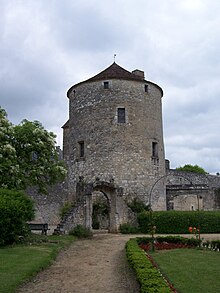Montaigne's tower
Conduits hidden between the first and second floor transmit sounds with good fidelity, which allowed Montaigne to hear Mass without leaving his bedroom in his old age.
While the corps de logis was almost entirely covered in paintings in Montaigne's life, only traces of the seccos subsist to this day.
[8] Forty-six of its forty-eight oak joists, as well as two supporting beams, were painted with Greek and Latin citations in Montaigne's time.
A dedication of the entire library to Montaigne's friend Étienne de La Boétie is also lost, as is the cabinet which contained over a thousand books.
The forty-six joists, distributed on three rows, are inscribed with a total of sixty-seven sayings[5] taken in their majority from the Bible and from classic authors (including Horace, Lucretius, Menander, and Sophocles).
Alain Legros argues that the order in which Montaigne would have encountered the quotations while walking in the room is perceptibly influential on the structure of some essays, notably the "Apology for Raymond Sebond."
One of the central theme of the paintings gathered in the space seems to have been nudity, a question metaphorically at the heart of the writing project of the Essays.


